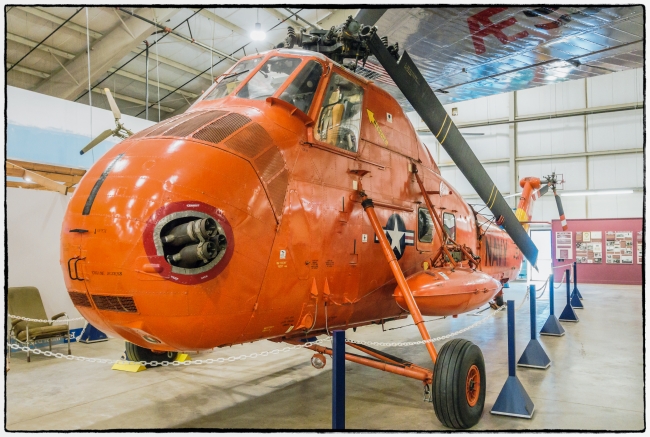According to the Museum’s website (which also provides technical specifications):
THIS AIRCRAFT IS ON LOAN FROM THE NATIONAL NAVAL AVIATION MUSEUM, PENSACOLA, FLORIDA
The Sikorsky S-58 was ordered by the military and designated the H-34. It was first used in a anti-submarine role by the U.S. Navy with the first flight in 1954. The U. S. Army used the H-34 (known as the “Choctaw”) as its principal transport helicopter from 1955 through 1964. The Marines adopted it in 1957 (known as the “Seahorse”) as their standard troop carrier for “vertical envelopment” landings, operating from carriers.
The H-34 in our museum was one of four modified for operation in Antarctica with the Navy and was given the “L” designation. It served as a rescue and utility craft with Squardron (sic) VX-6.
Other H-34s served in executive flight attachment, serving the President. Still others were used as recovery aircraft for the Mercury Program. Commercial models were used to transport cargo and passengers. They also were provided to over 23 countries. Westland in the United Kingdom was licensed was built (sic) a turbine-powered version as the “Wessex.”
.
This helicopter has a special meaning for me. As mentioned above the UK built a turbine-powered version called the “Westland Wessex”. When I was in high school I was a Royal Air Force Cadet and from time to time we would visit nearby airfields where we were allowed to fly in various aircraft (in some cases we were even allowed to fly the aircraft when it was already airborne and under the guidance of an instructor). During one of these visits I flew in a Westland Wessex – the first helicopter I ever flew in. It was quite an experience, especially since the pilots seemed to take great pleasure out of subjecting the poor unsuspecting cadets to the joys of autorotation. Wikipedia defines autorotation as:
…a state of flight in which the main rotor system of a helicopter or similar aircraft turns by the action of air moving up through the rotor, as with an autogyro, rather than engine power driving the rotor. The term autorotation dates to a period of early helicopter development between 1915 and 1920, and refers to the rotors turning without the engine. It is analogous to the gliding flight of a fixed-wing aircraft.
From our perspective it seemed as if the aircraft dropped like a rock and was falling out of the sky. Pretty scary if you don’t know what’s happening (and the aircrew made sure that we didn’t).
Taken with a Sony RX-100 M3.

